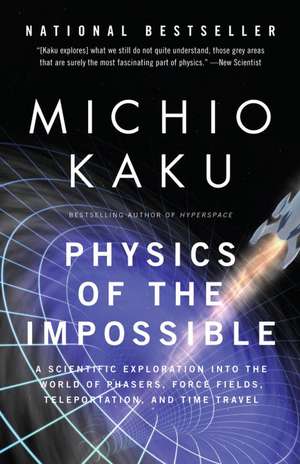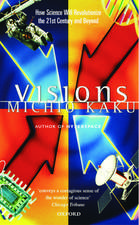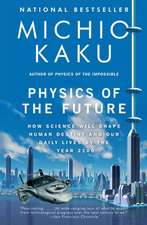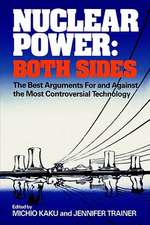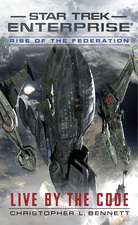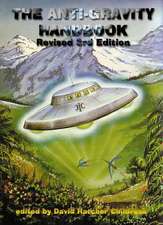Physics of the Impossible: A Scientific Exploration Into the World of Phasers, Force Fields, Teleportation, and Time Travel
Autor Michio Kakuen Limba Engleză Paperback – 31 mar 2009
| Toate formatele și edițiile | Preț | Express |
|---|---|---|
| Paperback (2) | 59.04 lei 22-33 zile | +21.94 lei 7-13 zile |
| Penguin Books – 27 mai 2009 | 59.04 lei 22-33 zile | +21.94 lei 7-13 zile |
| Anchor Books – 31 mar 2009 | 102.49 lei 3-5 săpt. |
Preț: 102.49 lei
Nou
Puncte Express: 154
Preț estimativ în valută:
19.61€ • 20.97$ • 16.35£
19.61€ • 20.97$ • 16.35£
Carte disponibilă
Livrare economică 27 martie-10 aprilie
Preluare comenzi: 021 569.72.76
Specificații
ISBN-13: 9780307278821
ISBN-10: 0307278824
Pagini: 329
Dimensiuni: 132 x 203 x 23 mm
Greutate: 0.27 kg
Editura: Anchor Books
ISBN-10: 0307278824
Pagini: 329
Dimensiuni: 132 x 203 x 23 mm
Greutate: 0.27 kg
Editura: Anchor Books
Notă biografică
Michio Kaku is the Henry Semat Professor of Theoretical Physics at the CUNY Graduate Center, a leader in the field of theoretical physics, and cofounder of string field theory. He is the author of several widely acclaimed science books, including Parallel Worlds, Visions, Beyond Einstein, and the bestseller Hyperspace. His books have been translated all over the world. He has written for Time, The Wall Street Journal, The New York Times, Discover Magazine, The London Daily Telegraph, New Scientist Magazine, and other periodcals.
Extras
1: FORCE FIELDS
I. When a distinguished but elderly scientist states that something is possible, he is almost certainly right. When he states that something is impossible, he is very probably wrong.
II. The only way of discovering the limits of the possible is to venture a little way past them into the impossible.
III. Any sufficiently advanced technology is indistinguishable from magic.
-ARTHUR C. CLARKE'S THREE LAWS
"Shields up!"
In countless Star Trek episodes this is the first order that Captain Kirk barks out to the crew, raising the force fields to protect the starship Enterprise against enemy fire.
So vital are force fields in Star Trek that the tide of the battle can be measured by how the force field is holding up. Whenever power is drained from the force fields, the Enterprise suffers more and more damaging blows to its hull, until finally surrender is inevitable.
So what is a force field? In science fiction it's deceptively simple: a thin, invisible yet impenetrable barrier able to deflect lasers and rockets alike. At first glance a force field looks so easy that its creation as a battlefield shield seems imminent. One expects that any day some enterprising inventor will announce the discovery of a defensive force field. But the truth is far more complicated.
In the same way that Edison's lightbulb revolutionized modern civilization, a force field could profoundly affect every aspect of our lives. The military could use force fields to become invulnerable, creating an impenetrable shield against enemy missiles and bullets. Bridges, superhighways, and roads could in theory be built by simply pressing a button. Entire cities could sprout instantly in the desert, with skyscrapers made entirely of force fields. Force fields erected over cities could enable their inhabitants to modify the effects of their weather-high winds, blizzards, tornados-at will. Cities could be built under the oceans within the safe canopy of a force field. Glass, steel, and mortar could be entirely replaced.
Yet oddly enough a force field is perhaps one of the most difficult devices to create in the laboratory. In fact, some physicists believe it might actually be impossible, without modifying its properties.
Michael Faraday
The concept of force fields originates from the work of the great nineteenth-century British scientist Michael Faraday.
Faraday was born to working-class parents (his father was a blacksmith) and eked out a meager existence as an apprentice bookbinder in the early 1800s. The young Faraday was fascinated by the enormous breakthroughs in uncovering the mysterious properties of two new forces: electricity and magnetism. Faraday devoured all he could concerning these topics and attended lectures by Professor Humphrey Davy of the Royal Institution in London.
One day Professor Davy severely damaged his eyes in a chemical accident and hired Faraday to be his secretary. Faraday slowly began to win the confidence of the scientists at the Royal Institution and was allowed to conduct important experiments of his own, although he was often slighted. Over the years Professor Davy grew increasingly jealous of the brilliance shown by his young assistant, who was a rising star in experimental circles, eventually eclipsing Davy's own fame. After Davy died in 1829 Faraday was free to make a series of stunning breakthroughs that led to the creation of generators that would energize entire cities and change the course of world civilization.
The key to Faraday's greatest discoveries was his "force fields." If one places iron filings over a magnet, one finds that the iron filings create a spiderweb-like pattern that fills up all of space. These are Faraday's lines of force, which graphically describe how the force fields of electricity and magnetism permeate space. If one graphs the magnetic fields of the Earth, for example, one finds that the lines emanate from the north polar region and then fall back to the Earth in the south polar region. Similarly, if one were to graph the electric field lines of a lightning rod in a thunderstorm, one would find that the lines of force concentrate at the tip of the lightning rod. Empty space, to Faraday, was not empty at all, but was filled with lines of force that could make distant objects move. (Because of Faraday's poverty-stricken youth, he was illiterate in mathematics, and as a consequence his notebooks are full not of equations but of hand-drawn diagrams of these lines of force. Ironically, his lack of mathematical training led him to create the beautiful diagrams of lines of force that now can be found in any physics textbook. In science a physical picture is often more important than the mathematics used to describe it.)
Historians have speculated on how Faraday was led to his discovery of force fields, one of the most important concepts in all of science. In fact, the sum total of all modern physics is written in the language of Faraday's fields. In 1831, he made the key breakthrough regarding force fields that changed civilization forever. One day, he was moving a child's magnet over a coil of wire and he noticed that he was able to generate an electric current in the wire, without ever touching it. This meant that a magnet's invisible field could push electrons in a wire across empty space, creating a current.
Faraday's "force fields," which were previously thought to be useless, idle doodlings, were real, material forces that could move objects and generate power. Today the light that you are using to read this page is probably energized by Faraday's discovery about electromagnetism. A spinning magnet creates a force field that pushes the electrons in a wire, causing them to move in an electrical current. This electricity in the wire can then be used to light up a lightbulb. This same principle is used to generate electricity to power the cities of the world. Water flowing across a dam, for example, causes a huge magnet in a turbine to spin, which then pushes the electrons in a wire, forming an electric current that is sent across high-voltage wires into our homes.
In other words, the force fields of Michael Faraday are the forces that drive modern civilization, from electric bulldozers to today's computers, Internet, and iPods.
Faraday's force fields have been an inspiration for physicists for a century and a half. Einstein was so inspired by them that he wrote his theory of gravity in terms of force fields. I, too, was inspired by Faraday's work. Years ago I successfully wrote the theory of strings in terms of the force fields of Faraday, thereby founding string field theory. In physics when someone says, "He thinks like a line of force," it is meant as a great compliment.
The Four Forces
Over the last two thousand years one of the crowning achievements of physics has been the isolation and identification of the four forces that rule the universe. All of them can be described in the language of fields introduced by Faraday. Unfortunately, however, none of them has quite the properties of the force fields described in most science fiction. These forces are
1. Gravity, the silent force that keeps our feet on the ground, prevents the Earth and the stars from disintegrating, and holds the solar system and galaxy together. Without gravity, we would be flung off the Earth into space at the rate of 1,000 miles per hour by the spinning planet. The problem is that gravity has precisely the opposite properties of a force field found in science fiction. Gravity is attractive, not repulsive; is extremely weak, relatively speaking; and works over enormous, astronomical distances. In other words, it is almost the opposite of the flat, thin, impenetrable barrier that one reads about in science fiction or one sees in science fiction movies. For example, it takes the entire planet Earth to attract a feather to the floor, but we can counteract Earth's gravity by lifting the feather with a finger. The action of our finger can counteract the gravity of an entire planet that weighs over six trillion trillion kilograms.
2. Electromagnetism (EM), the force that lights up our cities. Lasers, radio, TV, modern electronics, computers, the Internet, electricity, magnetism-all are consequences of the electromagnetic force. It is perhaps the most useful force ever harnessed by humans. Unlike gravity, it can be both attractive and repulsive. However, there are several reasons that it is unsuitable as a force field. First, it can be easily neutralized. Plastics and other insulators, for example, can easily penetrate a powerful electric or magnetic field. A piece of plastic thrown in a magnetic field would pass right through. Second, electromagnetism acts over large distances and cannot easily be focused onto a plane. The laws of the EM force are described by James Clerk Maxwell's equations, and these equations do not seem to admit force fields as solutions.
3 & 4. The weak and strong nuclear forces. The weak force is the force of radioactive decay. It is the force that heats up the center of the Earth, which is radioactive. It is the force behind volcanoes, earthquakes, and continental drift. The strong force holds the nucleus of the atom together. The energy of the sun and the stars originates from the nuclear force, which is responsible for lighting up the universe. The problem is that the nuclear force is a short-range force, acting mainly over the distance of a nucleus. Because it is so bound to the properties of nuclei, it is extremely hard to manipulate. At present the only ways we have of manipulating this force are to blow subatomic particles apart in atom smashers or to detonate atomic bombs.
Although the force fields used in science fiction may not conform to the known laws of physics, there are still loopholes that might make the creation of such a force field possible. First, there may be a fifth force, still unseen in the laboratory. Such a force might, for example, work over a distance of only a few inches to feet, rather than over astronomical distances. (Initial attempts to measure the presence of such a fifth force, however, have yielded negative results.)
Second, it may be possible to use a plasma to mimic some of the properties of a force field. A plasma is the "fourth state of matter." Solids, liquids, and gases make up the three familiar states of matter, but the most common form of matter in the universe is plasma, a gas of ionized atoms. Because the atoms of a plasma are ripped apart, with electrons torn off the atom, the atoms are electrically charged and can be easily manipulated by electric and magnetic fields.
Plasmas are the most plentiful form of visible matter in the universe, making up the sun, the stars, and interstellar gas. Plasmas are not familiar to us because they are only rarely found on the Earth, but we can see them in the form of lightning bolts, the sun, and the interior of your plasma TV.
Plasma Windows
As noted above, if a gas is heated to a high enough temperature, thereby creating a plasma, it can be molded and shaped by magnetic and electrical fields. It can, for example, be shaped in the form of a sheet or window. Moreover, this "plasma window" can be used to separate a vacuum from ordinary air. In principle, one might be able to prevent the air within a spaceship from leaking out into space, thereby creating a convenient, transparent interface between outer space and the spaceship.
In the Star Trek TV series, such a force field is used to separate the shuttle bay, containing small shuttle craft, from the vacuum of outer space. Not only is it a clever way to save money on props, but it is a device that is possible.
The plasma window was invented by physicist Ady Herschcovitch in 1995 at the Brookhaven National Laboratory in Long Island, New York. He developed it to solve the problem of how to weld metals using electron beams. A welder's acetylene torch uses a blast of hot gas to melt and then weld metal pieces together. But a beam of electrons can weld metals faster, cleaner, and more cheaply than ordinary methods. The problem with electron beam welding, however, is that it needs to be done in a vacuum. This requirement is quite inconvenient, because it means creating a vacuum box that may be as big as an entire room.
Dr. Herschcovitch invented the plasma window to solve this problem. Only 3 feet high and less than 1 foot in diameter, the plasma window heats gas to 12,000°F, creating a plasma that is trapped by electric and magnetic fields. These particles exert pressure, as in any gas, which prevents air from rushing into the vacuum chamber, thus separating air from the vacuum. (When one uses argon gas in the plasma window, it glows blue, like the force field in Star Trek.)
The plasma window has wide applications for space travel and industry. Many times, manufacturing processes need a vacuum to perform microfabrication and dry etching for industrial purposes, but working in a vacuum can be expensive. But with the plasma window one can cheaply contain a vacuum with the flick of a button.
But can the plasma window also be used as an impenetrable shield? Can it withstand a blast from a cannon? In the future, one can imagine a plasma window of much greater power and temperature, sufficient to damage or vaporize incoming projectiles. But to create a more realistic force field, like that found in science fiction, one would need a combination of several technologies stacked in layers. Each layer might not be strong enough alone to stop a cannon ball, but the combination might suffice.
The outer layer could be a supercharged plasma window, heated to temperatures high enough to vaporize metals. A second layer could be a curtain of high-energy laser beams. This curtain, containing thousands of crisscrossing laser beams, would create a lattice that would heat up objects that passed through it, effectively vaporizing them. I will discuss lasers further in the next chapter.
And behind this laser curtain one might envision a lattice made of "carbon nanotubes," tiny tubes made of individual carbon atoms that are one atom thick and that are many times stronger than steel. Although the current world record for a carbon nanotube is only about 15 millimeters long, one can envision a day when we might be able to create carbon nanotubes of arbitrary length. Assuming that carbon nanotubes can be woven into a lattice, they could create a screen of enormous strength, capable of repelling most objects. The screen would be invisible, since each carbon nanotube is atomic in size, but the carbon nanotube lattice would be stronger than any ordinary material.
So, via a combination of plasma window, laser curtain, and carbon nanotube screen, one might imagine creating an invisible wall that would be nearly impenetrable by most means.
Yet even this multilayered shield would not completely fulfill all the properties of a science fiction force field-because it would be transparent and therefore incapable of stopping a laser beam. In a battle with laser cannons, the multilayered shield would be useless.
I. When a distinguished but elderly scientist states that something is possible, he is almost certainly right. When he states that something is impossible, he is very probably wrong.
II. The only way of discovering the limits of the possible is to venture a little way past them into the impossible.
III. Any sufficiently advanced technology is indistinguishable from magic.
-ARTHUR C. CLARKE'S THREE LAWS
"Shields up!"
In countless Star Trek episodes this is the first order that Captain Kirk barks out to the crew, raising the force fields to protect the starship Enterprise against enemy fire.
So vital are force fields in Star Trek that the tide of the battle can be measured by how the force field is holding up. Whenever power is drained from the force fields, the Enterprise suffers more and more damaging blows to its hull, until finally surrender is inevitable.
So what is a force field? In science fiction it's deceptively simple: a thin, invisible yet impenetrable barrier able to deflect lasers and rockets alike. At first glance a force field looks so easy that its creation as a battlefield shield seems imminent. One expects that any day some enterprising inventor will announce the discovery of a defensive force field. But the truth is far more complicated.
In the same way that Edison's lightbulb revolutionized modern civilization, a force field could profoundly affect every aspect of our lives. The military could use force fields to become invulnerable, creating an impenetrable shield against enemy missiles and bullets. Bridges, superhighways, and roads could in theory be built by simply pressing a button. Entire cities could sprout instantly in the desert, with skyscrapers made entirely of force fields. Force fields erected over cities could enable their inhabitants to modify the effects of their weather-high winds, blizzards, tornados-at will. Cities could be built under the oceans within the safe canopy of a force field. Glass, steel, and mortar could be entirely replaced.
Yet oddly enough a force field is perhaps one of the most difficult devices to create in the laboratory. In fact, some physicists believe it might actually be impossible, without modifying its properties.
Michael Faraday
The concept of force fields originates from the work of the great nineteenth-century British scientist Michael Faraday.
Faraday was born to working-class parents (his father was a blacksmith) and eked out a meager existence as an apprentice bookbinder in the early 1800s. The young Faraday was fascinated by the enormous breakthroughs in uncovering the mysterious properties of two new forces: electricity and magnetism. Faraday devoured all he could concerning these topics and attended lectures by Professor Humphrey Davy of the Royal Institution in London.
One day Professor Davy severely damaged his eyes in a chemical accident and hired Faraday to be his secretary. Faraday slowly began to win the confidence of the scientists at the Royal Institution and was allowed to conduct important experiments of his own, although he was often slighted. Over the years Professor Davy grew increasingly jealous of the brilliance shown by his young assistant, who was a rising star in experimental circles, eventually eclipsing Davy's own fame. After Davy died in 1829 Faraday was free to make a series of stunning breakthroughs that led to the creation of generators that would energize entire cities and change the course of world civilization.
The key to Faraday's greatest discoveries was his "force fields." If one places iron filings over a magnet, one finds that the iron filings create a spiderweb-like pattern that fills up all of space. These are Faraday's lines of force, which graphically describe how the force fields of electricity and magnetism permeate space. If one graphs the magnetic fields of the Earth, for example, one finds that the lines emanate from the north polar region and then fall back to the Earth in the south polar region. Similarly, if one were to graph the electric field lines of a lightning rod in a thunderstorm, one would find that the lines of force concentrate at the tip of the lightning rod. Empty space, to Faraday, was not empty at all, but was filled with lines of force that could make distant objects move. (Because of Faraday's poverty-stricken youth, he was illiterate in mathematics, and as a consequence his notebooks are full not of equations but of hand-drawn diagrams of these lines of force. Ironically, his lack of mathematical training led him to create the beautiful diagrams of lines of force that now can be found in any physics textbook. In science a physical picture is often more important than the mathematics used to describe it.)
Historians have speculated on how Faraday was led to his discovery of force fields, one of the most important concepts in all of science. In fact, the sum total of all modern physics is written in the language of Faraday's fields. In 1831, he made the key breakthrough regarding force fields that changed civilization forever. One day, he was moving a child's magnet over a coil of wire and he noticed that he was able to generate an electric current in the wire, without ever touching it. This meant that a magnet's invisible field could push electrons in a wire across empty space, creating a current.
Faraday's "force fields," which were previously thought to be useless, idle doodlings, were real, material forces that could move objects and generate power. Today the light that you are using to read this page is probably energized by Faraday's discovery about electromagnetism. A spinning magnet creates a force field that pushes the electrons in a wire, causing them to move in an electrical current. This electricity in the wire can then be used to light up a lightbulb. This same principle is used to generate electricity to power the cities of the world. Water flowing across a dam, for example, causes a huge magnet in a turbine to spin, which then pushes the electrons in a wire, forming an electric current that is sent across high-voltage wires into our homes.
In other words, the force fields of Michael Faraday are the forces that drive modern civilization, from electric bulldozers to today's computers, Internet, and iPods.
Faraday's force fields have been an inspiration for physicists for a century and a half. Einstein was so inspired by them that he wrote his theory of gravity in terms of force fields. I, too, was inspired by Faraday's work. Years ago I successfully wrote the theory of strings in terms of the force fields of Faraday, thereby founding string field theory. In physics when someone says, "He thinks like a line of force," it is meant as a great compliment.
The Four Forces
Over the last two thousand years one of the crowning achievements of physics has been the isolation and identification of the four forces that rule the universe. All of them can be described in the language of fields introduced by Faraday. Unfortunately, however, none of them has quite the properties of the force fields described in most science fiction. These forces are
1. Gravity, the silent force that keeps our feet on the ground, prevents the Earth and the stars from disintegrating, and holds the solar system and galaxy together. Without gravity, we would be flung off the Earth into space at the rate of 1,000 miles per hour by the spinning planet. The problem is that gravity has precisely the opposite properties of a force field found in science fiction. Gravity is attractive, not repulsive; is extremely weak, relatively speaking; and works over enormous, astronomical distances. In other words, it is almost the opposite of the flat, thin, impenetrable barrier that one reads about in science fiction or one sees in science fiction movies. For example, it takes the entire planet Earth to attract a feather to the floor, but we can counteract Earth's gravity by lifting the feather with a finger. The action of our finger can counteract the gravity of an entire planet that weighs over six trillion trillion kilograms.
2. Electromagnetism (EM), the force that lights up our cities. Lasers, radio, TV, modern electronics, computers, the Internet, electricity, magnetism-all are consequences of the electromagnetic force. It is perhaps the most useful force ever harnessed by humans. Unlike gravity, it can be both attractive and repulsive. However, there are several reasons that it is unsuitable as a force field. First, it can be easily neutralized. Plastics and other insulators, for example, can easily penetrate a powerful electric or magnetic field. A piece of plastic thrown in a magnetic field would pass right through. Second, electromagnetism acts over large distances and cannot easily be focused onto a plane. The laws of the EM force are described by James Clerk Maxwell's equations, and these equations do not seem to admit force fields as solutions.
3 & 4. The weak and strong nuclear forces. The weak force is the force of radioactive decay. It is the force that heats up the center of the Earth, which is radioactive. It is the force behind volcanoes, earthquakes, and continental drift. The strong force holds the nucleus of the atom together. The energy of the sun and the stars originates from the nuclear force, which is responsible for lighting up the universe. The problem is that the nuclear force is a short-range force, acting mainly over the distance of a nucleus. Because it is so bound to the properties of nuclei, it is extremely hard to manipulate. At present the only ways we have of manipulating this force are to blow subatomic particles apart in atom smashers or to detonate atomic bombs.
Although the force fields used in science fiction may not conform to the known laws of physics, there are still loopholes that might make the creation of such a force field possible. First, there may be a fifth force, still unseen in the laboratory. Such a force might, for example, work over a distance of only a few inches to feet, rather than over astronomical distances. (Initial attempts to measure the presence of such a fifth force, however, have yielded negative results.)
Second, it may be possible to use a plasma to mimic some of the properties of a force field. A plasma is the "fourth state of matter." Solids, liquids, and gases make up the three familiar states of matter, but the most common form of matter in the universe is plasma, a gas of ionized atoms. Because the atoms of a plasma are ripped apart, with electrons torn off the atom, the atoms are electrically charged and can be easily manipulated by electric and magnetic fields.
Plasmas are the most plentiful form of visible matter in the universe, making up the sun, the stars, and interstellar gas. Plasmas are not familiar to us because they are only rarely found on the Earth, but we can see them in the form of lightning bolts, the sun, and the interior of your plasma TV.
Plasma Windows
As noted above, if a gas is heated to a high enough temperature, thereby creating a plasma, it can be molded and shaped by magnetic and electrical fields. It can, for example, be shaped in the form of a sheet or window. Moreover, this "plasma window" can be used to separate a vacuum from ordinary air. In principle, one might be able to prevent the air within a spaceship from leaking out into space, thereby creating a convenient, transparent interface between outer space and the spaceship.
In the Star Trek TV series, such a force field is used to separate the shuttle bay, containing small shuttle craft, from the vacuum of outer space. Not only is it a clever way to save money on props, but it is a device that is possible.
The plasma window was invented by physicist Ady Herschcovitch in 1995 at the Brookhaven National Laboratory in Long Island, New York. He developed it to solve the problem of how to weld metals using electron beams. A welder's acetylene torch uses a blast of hot gas to melt and then weld metal pieces together. But a beam of electrons can weld metals faster, cleaner, and more cheaply than ordinary methods. The problem with electron beam welding, however, is that it needs to be done in a vacuum. This requirement is quite inconvenient, because it means creating a vacuum box that may be as big as an entire room.
Dr. Herschcovitch invented the plasma window to solve this problem. Only 3 feet high and less than 1 foot in diameter, the plasma window heats gas to 12,000°F, creating a plasma that is trapped by electric and magnetic fields. These particles exert pressure, as in any gas, which prevents air from rushing into the vacuum chamber, thus separating air from the vacuum. (When one uses argon gas in the plasma window, it glows blue, like the force field in Star Trek.)
The plasma window has wide applications for space travel and industry. Many times, manufacturing processes need a vacuum to perform microfabrication and dry etching for industrial purposes, but working in a vacuum can be expensive. But with the plasma window one can cheaply contain a vacuum with the flick of a button.
But can the plasma window also be used as an impenetrable shield? Can it withstand a blast from a cannon? In the future, one can imagine a plasma window of much greater power and temperature, sufficient to damage or vaporize incoming projectiles. But to create a more realistic force field, like that found in science fiction, one would need a combination of several technologies stacked in layers. Each layer might not be strong enough alone to stop a cannon ball, but the combination might suffice.
The outer layer could be a supercharged plasma window, heated to temperatures high enough to vaporize metals. A second layer could be a curtain of high-energy laser beams. This curtain, containing thousands of crisscrossing laser beams, would create a lattice that would heat up objects that passed through it, effectively vaporizing them. I will discuss lasers further in the next chapter.
And behind this laser curtain one might envision a lattice made of "carbon nanotubes," tiny tubes made of individual carbon atoms that are one atom thick and that are many times stronger than steel. Although the current world record for a carbon nanotube is only about 15 millimeters long, one can envision a day when we might be able to create carbon nanotubes of arbitrary length. Assuming that carbon nanotubes can be woven into a lattice, they could create a screen of enormous strength, capable of repelling most objects. The screen would be invisible, since each carbon nanotube is atomic in size, but the carbon nanotube lattice would be stronger than any ordinary material.
So, via a combination of plasma window, laser curtain, and carbon nanotube screen, one might imagine creating an invisible wall that would be nearly impenetrable by most means.
Yet even this multilayered shield would not completely fulfill all the properties of a science fiction force field-because it would be transparent and therefore incapable of stopping a laser beam. In a battle with laser cannons, the multilayered shield would be useless.
Recenzii
“[Kaku explores] what we still do not quite understand, those grey areas that are surely the most fascinating part of physics.”
—New Scientist
“Kaku's latest book aims to explain exactly why some visions of the future may eventually be realized while others are likely to remain beyond the bounds of possibility. . . . Science fiction often explores such questions; science falls silent at this point. Kaku's work helps to fill a void.”
—The Economist
“A fascinating exploration of the interface between science and science fiction, extremely well researched, lively, and tremendously entertaining.”
—Fritjof Capra, author of The Tao of Physics and The Science of Leonardo
“Mighty few theoretical physicists would bother expounding some of these possible impossibilities, and Kaku is to be congratulated for doing so. . . . [He gets] the juices of future physicists flowing.”
—Los Angeles Times
—New Scientist
“Kaku's latest book aims to explain exactly why some visions of the future may eventually be realized while others are likely to remain beyond the bounds of possibility. . . . Science fiction often explores such questions; science falls silent at this point. Kaku's work helps to fill a void.”
—The Economist
“A fascinating exploration of the interface between science and science fiction, extremely well researched, lively, and tremendously entertaining.”
—Fritjof Capra, author of The Tao of Physics and The Science of Leonardo
“Mighty few theoretical physicists would bother expounding some of these possible impossibilities, and Kaku is to be congratulated for doing so. . . . [He gets] the juices of future physicists flowing.”
—Los Angeles Times
Cuprins
Preface
Acknowledgments
Part I: Class I Impossibilities
1: Force Fields
2: Invisibility
3: Phasers and Death Stars
4: Teleportation
5: Telepathy
6: Psychokinesis
7: Robots
8: Extraterrestrials and UFOs
9: Starships
10: Antimatter and Anti-universes
Part II: Class II Impossibilities
11: Faster Than Light
12: Time Travel
13: Parallel Universes
Part III: Class III Impossibilities
14: Perpetual Motion Machines
15: Precognition 2
Epilogue: The Future of the Impossible
Notes
Bibliography
Index
Acknowledgments
Part I: Class I Impossibilities
1: Force Fields
2: Invisibility
3: Phasers and Death Stars
4: Teleportation
5: Telepathy
6: Psychokinesis
7: Robots
8: Extraterrestrials and UFOs
9: Starships
10: Antimatter and Anti-universes
Part II: Class II Impossibilities
11: Faster Than Light
12: Time Travel
13: Parallel Universes
Part III: Class III Impossibilities
14: Perpetual Motion Machines
15: Precognition 2
Epilogue: The Future of the Impossible
Notes
Bibliography
Index
Descriere
A fascinating exploration of the science of the impossible--from death rays and force fields to invisibility cloaks--revealing to what extent such technologies might be achievable decades or millennia into the future.
